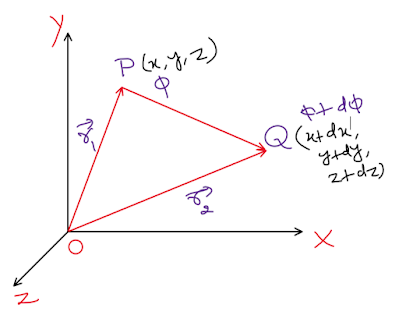For online classes & notes, Contact: quantaphysics3@gmail.com
Join Telegram: quantaphysics.com
Subscribe Youtube: BS quantaphysics
GRADIENT:
The gradient of a scalar field is a vector field & is represented by vector point function whose magnitude is equal to the maximum rate of change of scalar point function in a direction in which maximum rate of change occurs.
Let us consider two layers (scalar fields) P & Q, the values of scalar point functions are Φ & Φ+dΦ prospectively. So in moving from P to Q, the change in scalar field is dΦ.In moving from A to B, the change in displacement is dr & change in scalar field is dΦ. So the rate of change of scalar field is dΦ/dr.
In moving from A to C, the change in displacement is dr' & change in scalar field is dΦ. So the rate of change of scalar field is dΦ/dr'.
In moving from A to D, the change in displacement is dr'' & change in scalar field is dΦ. So the rate of change of scalar field is dΦ/dr''.
Since dr<dr'<dr'' , So we get dΦ/dr>dΦ/dr'>dΦ/dr''.
So, the maximum rate of change is dΦ/dr & it is along the normal. Hence the maximum rate of change occurs along the normal & this is the direction of gradient.
For online classes & notes, Contact: quantaphysics3@gmail.com
Join Telegram: quantaphysics.com
Subscribe Youtube: BS quantaphysics
GRADIENT in Cartesian Co-ordinate System:
Let P(x,y,z) is a point situated in 3D-coordinate system. Inside this scalar field, let a particle is moving from P to Q. Then the change in scalar field is from Φ to Φ+dΦ for the points P & Q respectively. Due to this change let the increment along X,Y Z-axes are dx,dy & dz respectively.
So, dΦ/dx= Rate of change of scalar field along X-axis.
dΦ/dy= Rate of change of scalar field along Y-axis.
dΦ/dz= Rate of change of scalar field along Z-axis.
Let Φ=Φ(x,y,z)

The gradient is defined as Subscribe Youtube: BS quantaphysics '
For online classes & notes, Contact: quantaphysics3@gmail.com
Join Telegram: quantaphysics.com
PROPERTIES OF GRADIENT:
2. The line integral a vector field around a closed path is zero, if the vector field is represented by gradient of a scalar function.
APPLICATION OF GRADIENT:
1. To find the unit normal:
If Φ(x,y,z) represents the scalar point function & ∇Φ represents the gradient, then the unit normal to the surface is defined as
The component of ∇Φ in the direction of of a vector D , is defined as
Q1: Find the unit normal to the following curve at (2,1)
Contact for all Doubts & Online Classes (+2 & +3) : quantaphysics3@gmail.com
Read Spiritual Article & Manage Your Time & act likeTimeless
Model syllabus (+3): Downoad
List of all practicals(+3): Download
Get all Books: Download
For online classes & notes, Contact: quantaphysics3@gmail.com Join Telegram: quantaphysics.com Subscribe Youtube: BS quantaphysics NOTES:For online classes & notes, Contact: quantaphysics3@gmail.com Join Telegram: quantaphysics.com Subscribe Youtube: BS quantaphysics
For online classes & notes, Contact: quantaphysics3@gmail.com
Join Telegram: quantaphysics.com
Subscribe Youtube: BS quantaphysics
NOTES:
For online classes & notes, Contact: quantaphysics3@gmail.com
Join Telegram: quantaphysics.com
Subscribe Youtube: BS quantaphysics
- How to Prepare for IIT-JAM ⇠ ⇠ Click Here
- How to prepare for JEST ⇠ ⇠ Click Here
















Post a Comment